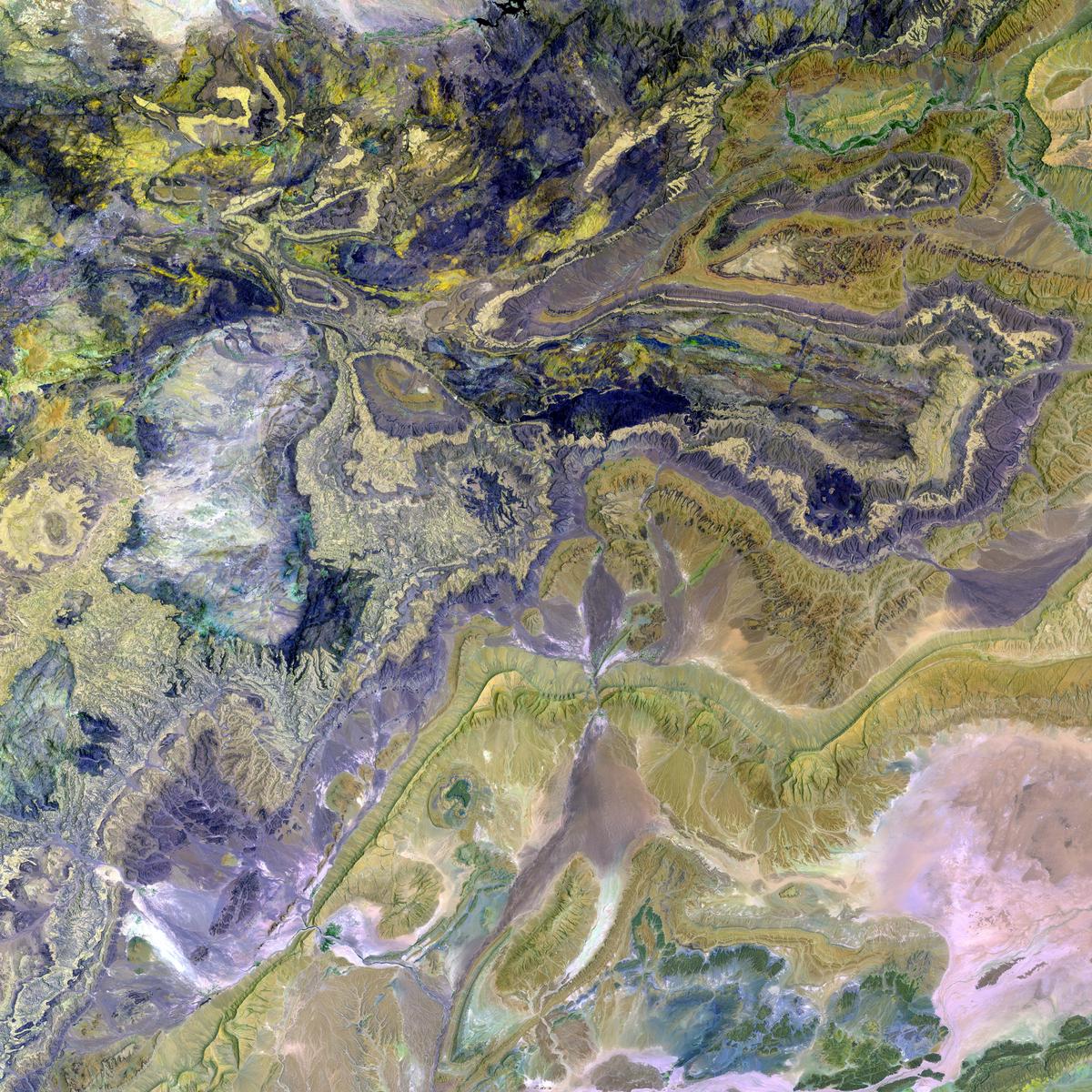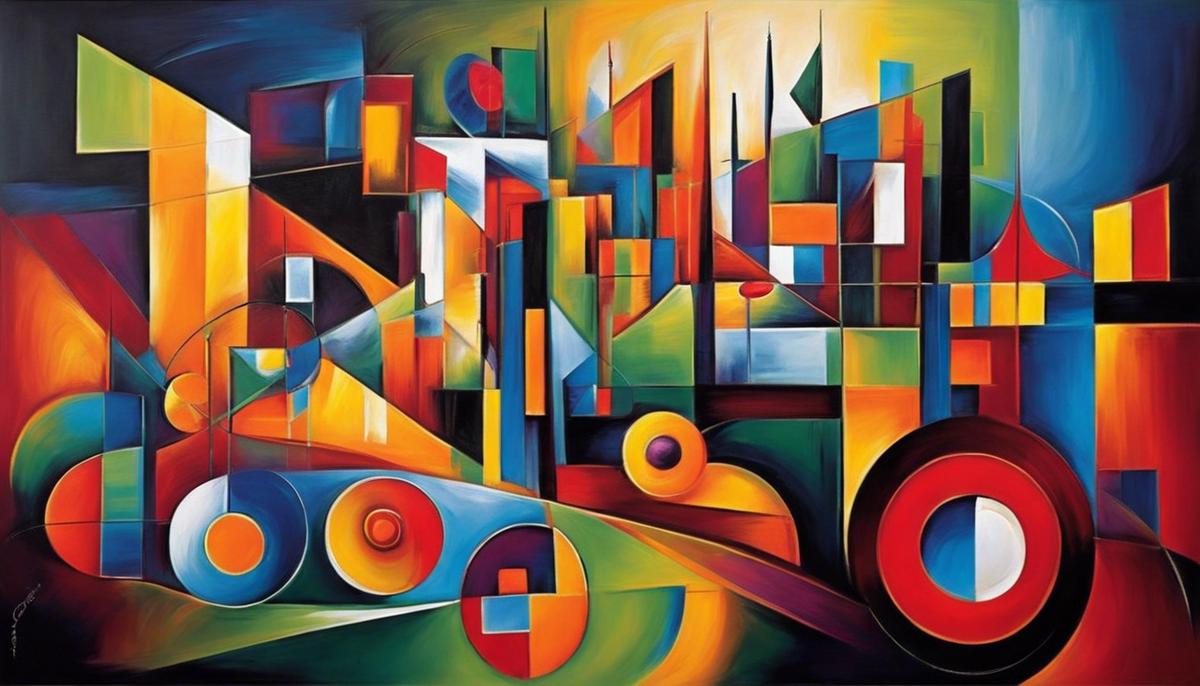The annals of art history are punctuated by movements that redefine the way we perceive and interpret the visual world, none more so than Cubism, a revolutionary aesthetic that dismantled traditional forms and set the stage for modern art. This essay embarks upon a journey to unravel the foundations of this movement, tracing the inception of Cubism through the seismic work of Pablo Picasso and Georges Braque. We delve into the striking influence of African art, exploring how this synergy of cultures precipitated a radical shift from representational imagery to an avant-garde tapestry of multiple perspectives and abstracted reality.
Foundations of Cubism
The advent of Cubism in the early 20th century signalled a remarkable paradigm shift in the annals of modern art. This movement eschewed the traditional perspective of art that champions three-dimensional representation, opting instead for an abstract approach that deconstructs objects into their geometric constituents.
Pioneered by eminent artists such as Pablo Picasso and Georges Braque, Cubism challenged the Renaissance-era conception of mimetic art, the notion that art should imitate life. Their vision led to the creation of a visual language that could render multiple perspectives simultaneously, presenting a fragmented view of reality that echoed the complex nature of the modern era.
Comprising two distinct phases, Analytic Cubism and Synthetic Cubism, the movement first dissected and analysed forms. Through monochromatic palettes and intricate compositions, the Analytic phase laid bare the core geometric shapes underpinning our visual understanding of the world. In contrast, Synthetic Cubism introduced new elements and colours into the compositions, moving towards simpler shapes and brighter palettes. This phase also witnessed the advent of collage, further expanding the boundaries of what could be considered fine art.
By presenting objects from a multitude of viewpoints, Cubism allowed for a more profound interpretation of subjects, relying on the viewer’s intellect to reconstruct the composite image into a coherent whole. This multifaceted approach to representation reflected the rapidly changing society of the time, one that was becoming increasingly multifarious and connected.
The intellectual rigour and bold reimagining that Cubism introduced had far-reaching influences, not only on subsequent art movements such as Futurism and Dadaism but also resonating with architecture, literature, and even influencing the development of early 20th-century physics theories. The Cubist tenet that what we see is a constructed perception rather than an objective truth prefigured the conceptual upheavals of quantum mechanics and the relativity of space and time.
In conclusion, Cubism’s revolutionary approach laid down the philosophical and aesthetic foundations for a broad spectrum of modernist experimentation. Its legacy endures in contemporary practice, as artists continue to grapple with the nature of reality and the diverse ways it can be rendered through art. Cubism has fundamentally reshaped our understanding of how art relates to the world, and its revolutionary character continues to inspire and provoke.

Analytic vs. Synthetic Cubism
Analytic and Synthetic Cubism: Dissecting Their Divergences
Cubism, manifesting in two cardinal phases—Analytic and Synthetic—revolutionized the art world by challenging conventional representation. Although the foundations of the movement embraced a departure from traditional illusionistic art, the two strands differed significantly in both methodology and aesthetic result.
During the Analytic Cubism epoch, artists meticulously deconstructed objects into basic geometric forms, rearranging them on a flattened space as if analysing their structure. The canvases were pervaded with muted tones, primarily greys and browns, to assuage any distraction from the complexity of form. This fragmentation obscured the depicted reality, prompting observers to engage with art more intellectually, piecing together the disjointed visual cues presented.
Transitioning to Synthetic Cubism, the trend moved towards construction rather than deconstruction. With an expanded palette boasting bold colours and textures, artists sought to synthesize, or combine, disparate elements directly into their work. Innovative techniques, such as papier collé (pasted paper), invigorated pieces with tactile, real-world connections, a stark departure from the nebulous forms of Analytic Cubism. This phase signalled a shift from an introspective dissection of objects to an assemblage of signifiers in collage-like structures, incorporating materials like newspapers and wrappers, thus infusing paintings with a social commentary or quotidian context.
A critical differentiation lies in the narrative capacity. Whereas Analytic Cubism offered abstract, almost elusive narratives, requiring arduous contemplation, Synthetic Cubism presented clearer themes through its literal and metaphorical layers. The composite creations of the Synthetic phase were more visually accessible and iconographic, erasing previous boundaries and cultivating a more dynamic interaction with the viewer.
Naturally, such divergence in Cubist philosophy generated a fertile ground for the proliferation of aesthetic inquiry. Henceforth, art would not merely represent the physical world but would serve as a medium for profound exploration of form, structure, and meaning. This dichotomy within Cubism, a microcosm of the movement’s transformative effect, continues to spark discourse, influencing artists who strive for a visual language that encapsulates the multifarious nature of experience and cognition.

Pablo Picasso’s Guernica
Moving beyond the rudimentary foundations of Cubism, which have been keenly elaborated upon, it becomes imperative to underline the significance of Pablo Picasso’s ‘Guernica’. This lauded creation, painted in 1937, stands as a testament to art’s prowess in encapsulating and responding to socio-political turmoils.
‘Guernica’ as a Symbol of Anti-War Sentiment
Within the oeuvre of Picasso’s work, ‘Guernica’ heralds as a poignant departure from abstraction to a narrative deeply entrenched in historical context. It is an emblematic anti-war piece, provoked by the bombing of the Basque town of Guernica during the Spanish Civil War. The monochromatic scale, retained from the Analytic Cubism period, seizes upon the scene’s stark and visceral emotion. Each twist of a limb and cry in the visage of its figures bursts forth with a universal langour against the devastations of war.
Reflection of Historical Context in Structure and Style
The structure of ‘Guernica’ diverges from previous Cubist compositions by abandoning the non-representative ethos. Instead, figurative elements emerge amidst the characteristic multi-perspective approach. This stylistic blend allows the viewer to engage with an instantaneous representation of suffering, while concurrently dissecting the layers of agony through abstract form.
Educational Imperative of ‘Guernica’
Throughout scholastic settings, ‘Guernica’ serves not only as an artistic model but as an invaluable historical artefact. Scholars from myriad disciplines—be it art history, political science, or peace studies—discern in ‘Guernica’ a multilayered commentary. Through the visual portrayal of rubble and ruin, it delineates the perils and pitfall of fascist ideology and the odious consequences of military aggression.
Reception and Legacy
Upon its unveiling, ‘Guernica’ catalysed a dramatic response within the art community and wider public discourse. As a potent symbol of peace, it transcended the boundaries of artistic intent and assimilated into the global consciousness as a declaration against war atrocities. Despite divergent interpretations of its painted forms, the emotional undercurrents resonate unequivocally with a call for humanism.
To conclude, ‘Guernica’ embodies the very essence of art’s social function and demonstrates a significant turning point in Picasso’s career. This masterpiece persistently invites contemporary artists and audiences to reflect on the dynamics between art, conflict, and collective memory. As a cornerstone of twentieth-century art, the gravity of ‘Guernica’ is resounding, making it one of Picasso’s most influential and imperishable works.

The Global Influence of Cubism
Despite the previous comprehensive discussions of Cubism’s conceptual origins and dynamic evolution, it is imperative to consider the broader cultural and psychological implications of the movement, particularly with respect to its conjunction with societal narratives and its dissecting, reassembling gaze upon historical occurrences.
The advent of Cubism offered not only a visual but also a conceptual kaleidoscope through which the tumult of the early twentieth century could be discerned. Indeed, part of Cubism’s far-reaching impact lies in its capacity to convey multi-angled perspectives simultaneously, presenting a fragmented yet holistic view of its subjects. For instance, the multifaceted nature of Cubist works serves as a metaphor for the complexity of human experience, echoing the manifold viewpoints and fractured realities that characterize modern existence.
The influence of Cubism extends to the way artists grapple with political and historical events. Cubist artists often engaged with their contemporary milieu, embedding within their works coded commentary on geopolitical situations, the dynamics of power, and the human condition itself. Such art does not merely reflect back societal norms but actively participates in shaping discourse. It becomes a tool of rebellion, a canvas for ideological contestation, and a frame for cultural examination.
In educational contexts, Cubism has proven to be a pivotally instructive movement, enabling the deconstruction of traditional narratives and providing a lens through which students can dissect the anatomy of an artwork. This method of learning encourages a deeply analytical approach, fostering critical thinking and permitting the unearthing of subtexts in seemingly ambiguous or puzzled forms.
Cubist art, with its fractured vistas and reconstituted reality, has also demonstrated a remarkable aptitude for capturing the zeitgeist of an era, encapsulating anxieties, aspirations, and the collective consciousness of its time. Its enduring influence on the global art scene can be partly attributed to its alignment with the human proclivity to find meaning amid chaos, to reconstruct coherence from the rubble of disjointed experience. By embodying the interplay between societal events and individual perception, Cubist artworks serve as historical markers that converse with both the past and present, informed by conflict but reaching towards comprehension and, perhaps, resolution.
Moreover, the social function of art, as exemplified by Cubism, cannot be overstated. The movement’s profound contemplation on form and space has lent itself to articulating societal strain and exploring themes of remembrance and retrospection. Art under the Cubist lens transcends mere aesthetic appreciation, confronting viewers with the immediacy of their sociopolitical reality and the enduring human struggle to make sense of the world’s apparent disarray.
Cubism’s legacy persists, compelling the contemporary art world to continually revisit and reassess its past convictions and to confront the present through this prism of fragmented perspective. This enduring dialogue championed by Cubism fortifies its status as a foundational and transformative movement within the global art scene.

Photo by magicpattern on Unsplash
Cubism in Contemporary Art
Cubism’s Resonance in Contemporary Art: A Dissection of Its Lifeblood
Cubism’s intricate association with contemporary art is an unending thread that weaves through the fabric of modern creativity. Despite the elapsed century since its inception, discerning eyes can trace Cubism’s genetic markers within numerous disciplines of artistic endeavour. Today, contemporary artists, driven by an insatiable quest to express the multifaceted nature of reality, continually borrow from the Cubist syntax.
At the core of Cubist philosophy is the notion that reality is not a fixed entity but a fluid construct, perceptible from multiple vantage points. This intellectual rebellion against the stringent boundaries of traditional representation continues to empower artists. Contemporary artworks, often imbued with a Cubist sensibility, reject passive observation for active participation; the viewer is conscripted as a decipherer of complex visual narratives.
The dissolution of familiar forms—a hallmark of Cubism—ensures its enduring appeal and relevance, reflecting a world that defies simplification. In an era dominated by digital technology, where the interplay between the virtual and the tangible blurs lines of demarcation, Cubist techniques resonate louder. Today’s artists draw upon Cubism’s legacy of fragmentation and reassembly, crafting works that mirror the interconnected yet disjointed landscape of modern life.
Cubism’s footprint on visual language extends to the underlying structure of images. Contemporary graphic design, with its emphasis on geometry and abstraction, owes a debt of gratitude to Cubism. These designers harness Cubist principles, manipulating and layering shapes to create a sense of depth and complexity that belies the two-dimensional plane.
Within the three-dimensional realm, Cubism’s influence persists. Sculptors and architects continue to explore the deconstruction and reconfiguration of space and form. Instinctual manipulation of volume, along with the interplay of shadow and light, reflects the Cubist doctrine that what is omitted is just as telling as what is included.
In the sphere of education, Cubism has secured a pivotal role in elucidating critical thinking and visual literacy. In dissecting a Cubist work, learners must navigate a labyrinth of symbolism and abstraction, training their minds to recognise and appreciate nuance and subtext—skills that are paramount in a media-saturated epoch.
The theoretical underpinnings of Cubism—its quest to transcend the superficial and to excavate a deeper truth—continue to percolate through academic discourses in philosophy and semiotics. The Cubist approach compels one to challenge the status quo, whether it be in aesthetics, perception, or communication. It propels the ongoing journey to dissect the nature of our reality, proving that Cubism’s trajectory is far from static; it is dynamic and evolutionarily resilient.
Cubism’s synchrony with the tempo of contemporary art forms an interconnected tapestry where past influences persist and flourish within the present. The dialogue between traditional Cubist methods and cutting-edge artistic practices ensures that the reverberations of this monumental movement will continue to shape our visual and conceptual landscape. In this respect, Cubism is not merely historical but vibrantly alive, pulsating within the veins of present-day creativity and beyond.

Conservation and Display of ‘Guernica’
The Conservation and Exhibition Challenges of ‘Guernica’
The conservation and exhibition of ‘Guernica,’ Picasso’s monumental piece, embody a complex interplay of factors that bear important implications for curators and conservators alike. A work replete with historical gravitas and fraught with the visceral portrayal of wartime atrocity, ‘Guernica’ presents a unique set of challenges that extend beyond mere preservation of physical integrity.
One of the foremost challenges hinges on the delicate balance between conservation efforts and the piece’s accessibility to the public. As an iconic anti-war symbol, ‘Guernica’ inherently carries a pedagogic responsibility, its presence within a public domain serves as a powerful educational tool. However, environmental factors intrinsic to public display settings, such as variations in lighting, temperature, and humidity, directly threaten the artwork’s longevity. Constant vigilance and the adoption of state-of-the-art preservation technologies are imperative to mitigate such risks.
Transporting ‘Guernica’ compounds these complexities. Given its size and significance, the logistics of moving the mural safely between locations demand extraordinary measures. Stress and potential damage to the canvas during transit must be minimised through meticulous planning and sophisticated packing techniques. This not only preserves the artwork but also reinforces the notion of art’s intrinsic value that transcends spatial confines.
The physical integrity of ‘Guernica’ is continuously menaced by the passing of time. Originally executed on canvas with oil paint, the materials used by Picasso have aged, bringing forth issues related to cracking, fading, and the canvas’s potential to become brittle. These material challenges necessitate an ongoing dialogue between conservation practitioners and researchers who must decode the painting’s chronological woes while remaining unwaveringly faithful to the original aesthetic and intent of the artwork.
Another substantial consideration is the psychological and emotional conservation of ‘Guernica.’ The artwork’s poignant narrative, depicting the aftermath of the aerial bombing of the Basque town of Guernica during the Spanish Civil War, is underpinned by an emotive potency that must be preserved and conveyed accurately to viewers. The dilemma here lies within the portrayal of anguish without triggering overwhelming distress in the audience while ensuring that the weight of history is never diluted.
Interfacing with these concerns is the role of didactics in the presentation of ‘Guernica.’ Crafting an interpretative framework that equitably caters to diverse visitor cohorts is a paramount task. Educators and curators must work assiduously to scaffold a learning experience that resonates with a general worldview while providing deeper analytical insights. Such educational endeavours must harmonise with the exhibit, enhancing understanding without obscuring the essence and message of the artwork.
Finally, ‘Guernica’s’ digital preservation and representation have become increasingly pertinent in the digital era. Accurate digital reproduction poses its own set of quandaries—from issues around colour fidelity to decisions on virtual exhibit space design, all the while considering how such representations may impact a viewer’s encounter with the mural. With the ascent of virtual reality and augmented reality, potential for the digital sphere to act as a supplementary avenue for experiencing ‘Guernica’ has surged, but approaches must be scrutinised for their ability to uphold the integrity and impact of the original work.
Thus, the conservation and exhibition of ‘Guernica’ require a multifaceted approach. One that is respectful of its material conditions, historical context, educational imperatives, and emotional resonance. In these challenges lie the custodial stewardship of an art piece that is much more than the sum of its parts—a stark narrative frozen in time, a perpetual reminder of the horrors of war and silent testimony to the indomitable spirit of peace.

Cubism’s undulating reach across time and space is a testament to its undying relevance, embedding itself into the sinews of contemporary art and the growing expanse of digital realms. As we reflect upon the storied existence of ‘Guernica’, from its creation amidst tumultuous times to the meticulous conservation and subsequent pedagogical display, the canvas continues to resonate as a poignant emblem of both artistic innovation and historical testimony. Cubism, in its myriad forms and phases, persists as a cornerstone of creativity, challenging and inspiring artists to gaze through the multifaceted lens of abstraction and reconfigure the mosaic of human experience.
























